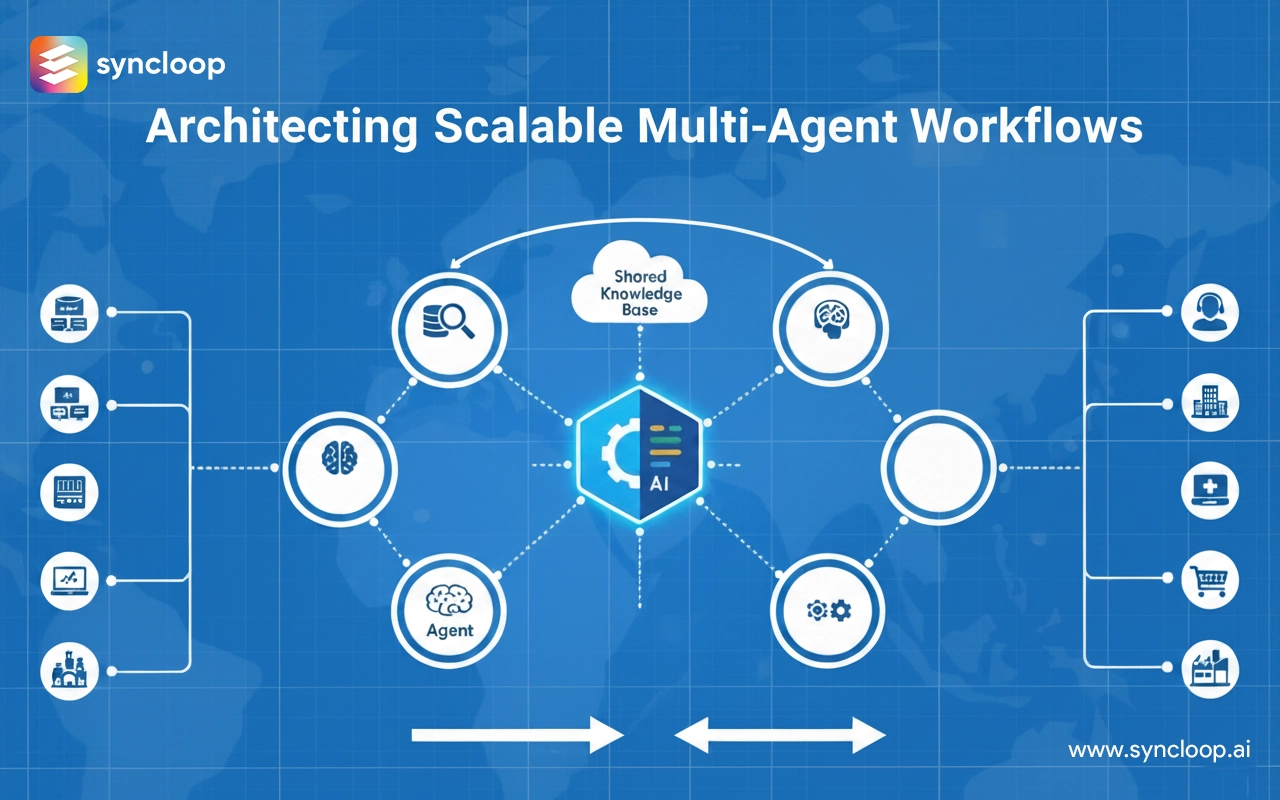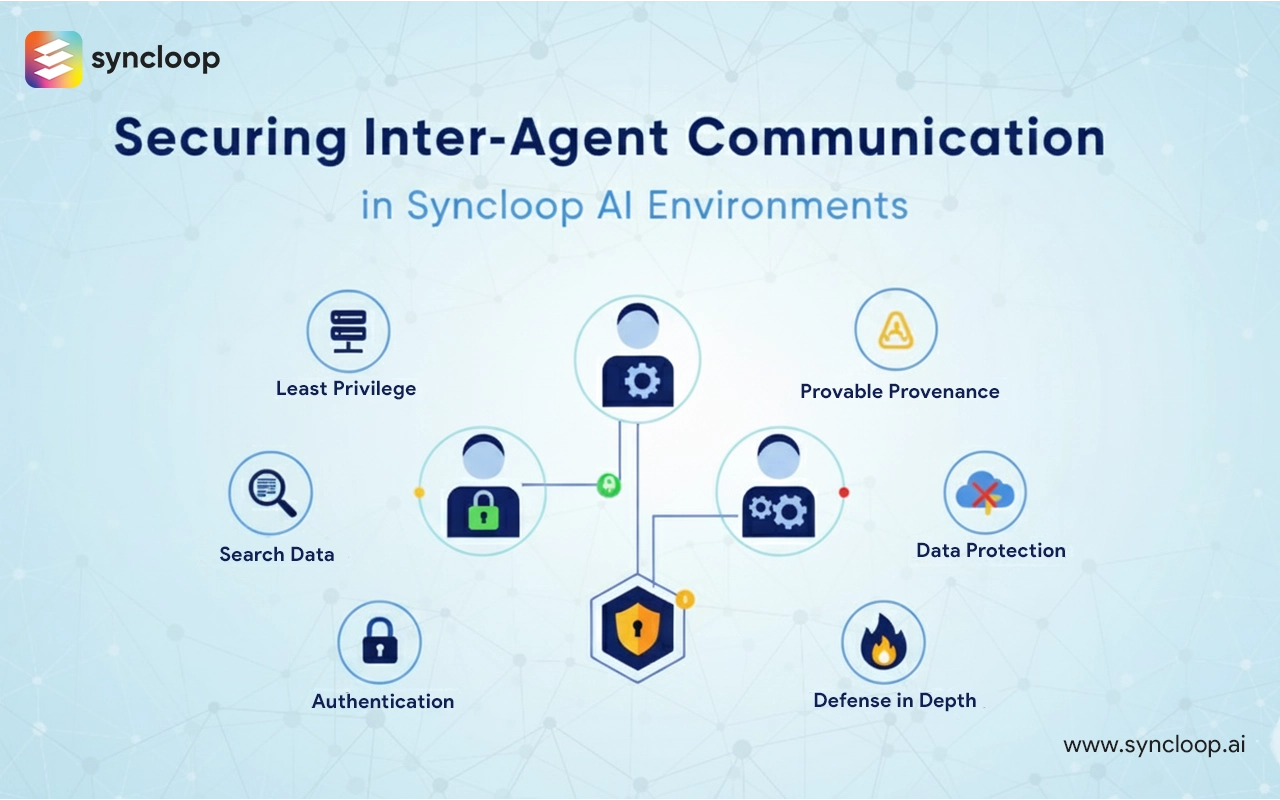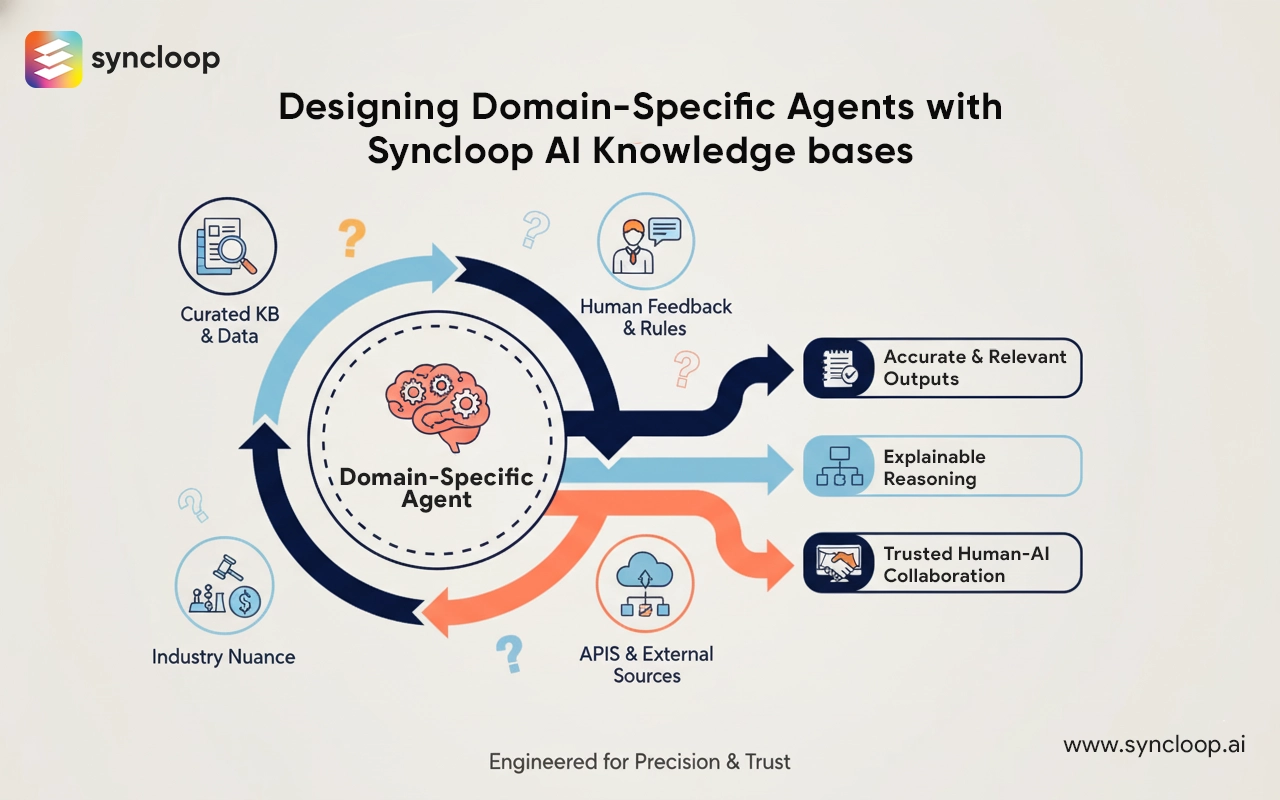Architecting Scalable Multi-Agent Workflows on Syncloop AI
Posted by: Emily Johnson | October 26, 2025

As organizations increasingly adopt AI-driven solutions to enhance efficiency and intelligence in operations, one challenge consistently emerges —scalability. Traditional automation platforms, while efficient for static or rule-based workflows, often crumble under the pressure of dynamic workloads and context-driven decision-making. Enter Syncloop AI, a platform designed from the ground up to harness the power of multi-agent systemsfor scalable, intelligent, and adaptive automation.
Scalability in AI automation is no longer just about handling more users or processing more data; it’s about maintaining intelligence, coordination, and adaptability as the system grows. Syncloop AI achieves this through a unique architecture where autonomous agents collaboratethrough APIs, retrieve contextual information from knowledge bases, and collectively make decisions —all while maintaining optimal performance.
In this blog, we’ll explore how Syncloop AI enables scalable multi-agent workflows, the principles behind its architecture, and why it represents the future of distributed intelligence in enterprises.
The Foundation of Scalable Multi-Agent Design
Scalability begins with modularity —the ability to build, extend, and evolve systems without disruption. Syncloop AI’s architecture embraces this principle by treating every agent as an independent yet interoperable entity
Each agent in Syncloop AI is designed to perform specific, well-defined roles —whether it’s data retrieval, reasoning, decision-making, or validation. Instead of building one large AI model that does everything, Syncloop AI promotes a distributed architecture where specialized agents collaborate to achieve outcomes.
This design achieves scalability on multiple levels:
- Functional scalability: by allowing new agents to be added to handle emerging tasks.
- Computational scalability: by distributing workload across agents and parallelizing processes.
- Cognitive scalability: by enabling agents to access shared knowledge bases and collectively improve reasoning.
This modular, API-first design ensures that even as workflows expand, the system’s intelligence and responsiveness remain intact.
How Syncloop AI Orchestrates Multi-Agent Collaboration
Syncloop AI’s strength lies in its ability to seamlessly orchestrate multiple agents in real time. At the heart of this orchestration lies API-driven communication. Every agent within Syncloop AI exposes and consumes APIs to communicate with other agents or external systems.
The Orchestration Layerin Syncloop AI acts asthe conductor of this digital symphony —assigning tasks, managing dependencies, and ensuring that every agent operates within context. This coordination ensures that the right agent handles the right problem at the right time.
This distributed intelligence enables:
- A Retriever Agent fetches data from the knowledge base.
- An Analyzer Agent processes and interprets that data.
- A Validator Agent checks for compliance and consistency.
- A Decision Agent synthesizes results and executes an action
All of this happens within milliseconds, making it possible to achieve complex reasoning at scale.
The Role of APIs in Scalability
APIs are the invisible nervous system of Syncloop AI. They provide the channels through which agents share data, insights, and instructions. Because Syncloop AI’s architecture is API-centric, scaling workflows doesn’t mean rewriting code —it simply means connecting more agents or extending capabilities through existing endpoints
This API-first design offers several benefits:
- Ease of integration: Agents can connect to enterprise systems like CRM, ERP, or data warehouses.
- Interoperability: Agents can communicate across languages, models, and protocols.
- Security: Every transaction between agents can be authenticated, logged, and monitored.
- Reusability: APIs allow agents to be reused in multiple workflows or domains.
In essence, APIs enable Syncloop AI to grow organically —like adding new neurons to a living brain, each enhancing the overall intelligence of the network.
Scalability Through Parallelism and Decentralization
One of the defining characteristics of Syncloop AI is its ability to scale horizontally through parallel agent execution.
Instead of relying on a centralized controller that dictates every step, Syncloop AI empowers agents to act independently and simultaneously. Each agent can process its assigned tasks in parallel while the orchestration layer ensures coherence and consistency across the workflow.
This decentralized approach reduces latency, prevents bottlenecks, and enables the system to handle massive volumes of requests concurrently. Whether processing thousands of customer queries or running predictive analytics across multiple data streams, Syncloop AI scales effortlessly.
Parallelism also introduces fault tolerance—if one agent fails or experiences latency, others can continue to operate, ensuring system resilience.
Dynamic Knowledge Access for Scalable Intelligence
At the heart of every intelligent decision lies access to accurate, contextually relevant information. Syncloop AI integrates Retrieval-Augmented Generation (RAG) and knowledge basesthat allow agents to retrieve the most relevant data in real time
This means that as workflows expand, agents don’t lose efficiency or accuracy. Instead, they dynamically pull the data they need to reason intelligently, regardless of scale.
Unlike static rule-based systems, Syncloop AI agents continually update their understanding through context retrieval. This ensures scalability not just in processing power, but in intelligence quality — as the system grows, so does its knowledge depth.
Load Management and Resource Optimization
Scalability isn’t just about adding more resources; it’s about optimizing the ones you have. Syncloop AI employs smart load management strategies that dynamically allocate agents and resources based on workload demands.
When demand spikes, new agent instances can be spun up automatically to balance the load. When demand falls, unused instances are scaled down to conserve resources.
This elasticity ensures that enterprises only use what they need, when they need it —keeping operations cost-effective without compromising performance.
Security and Governance at Scale
As systems scale, so does the risk surface. Syncloop AI integrates robust security and governance frameworks to ensure every interaction remains secure, auditable, and compliant.
Each agent’s actions are tracked through detailed logs, ensuring full transparency. API-level access control ensures that agents can only perform authorized operations.Additionally, encryption protocols safeguard inter-agent communications, maintaining data confidentiality across the ecosystem.
This built-in governance framework ensures that scalability never comes at the cost of security or compliance.
Why Businesses Choose Syncloop AI for Intelligent Automation
Human and Machine Collaboration at Scale
Even in large-scale systems, human oversight remains vital. Syncloop AI supports a human-in-the-loopmodel, allowing experts to monitor, approve, or adjust agent actions when needed.
This balance between autonomy and oversight ensures that enterprises can scale with confidence —knowing that automation remains aligned with human goals and ethical considerations.
Moreover, human agents can interact directly with digital agents through APIs or conversational interfaces, creatingan integrated ecosystem where machine intelligence complements human expertise.
Industry Use Cases of Scalable Multi-Agent Workflows
Syncloop AI’s scalability has real-world implications across diverse industries:
- Banking and Finance: Fraud detection systems can scale dynamically to analyze thousands of transactions per second using specialized agents for monitoring, validation, and escalation.
- Healthcare: Scalable agent workflows streamline patient data management, diagnostics, and administrative processes while maintaining compliance with data regulations.
- Retail and E-commerce: Multi-agent workflows manage inventory, predict demand, and optimize supply chains with real-time intelligence.
- Manufacturing: Intelligent agents coordinate machinery maintenance schedules, quality checks, and production analytics at scale.
In each scenario, scalability is not merely about handling volume —it’s about sustaining intelligence, adaptability, and coordination as operations grow.
Building for theFuture: The Syncloop AI Advantage
Scalable multi-agent systems are not just a technical innovation —they are the future of enterprise intelligence. Syncloop AI stands out because it combines scalability with simplicity. Developers can design and deploy complex workflows without needing to manage underlying infrastructure or orchestration complexities.
Through its API-driven design, modular architecture, and knowledge-integrated intelligence, Syncloop AI allows organizations to evolve from static automation to dynamic, intelligent ecosystems capable of learning and adapting continuously
The future belongs to enterprises that can scale intelligence —not just infrastructure —and Syncloop AI is the platform making that future possible today.
Conclusion
Scalability is the lifeblood of modern automation. As businesses evolve, their systems must not only handle growth but also think, adapt, and collaborate intelligently. Syncloop AI makes this possible through its multi-agent architecture, where independent yet connected agents create workflows that are fluid, resilient, and self-optimizing
By combining API-driven integration, dynamic knowledge retrieval, and distributed intelligence, Syncloop AI empowers organizations to scale seamlessly —from startups to global enterprises —without losing context, accuracy, or control.
In a world where data, complexity, and expectations continue to grow, Syncloop AI isn’t just automating processes; it’s architecting the future of intelligent, scalable enterprise ecosystems.
Back to Blogs







